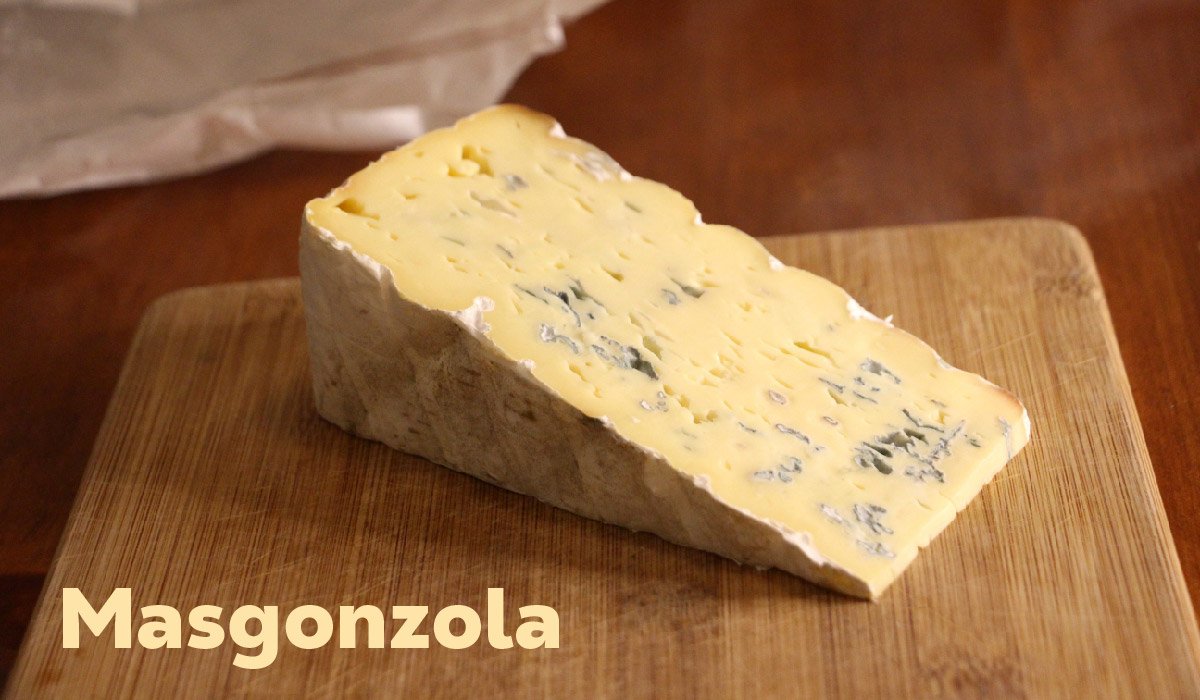Blog
Masgonzola Cheese Guide: The Creamy Delight You’ll Instantly Love

Masgonzola is quickly gaining popularity among cheese lovers and culinary explorers alike, thanks to its uniquely rich flavor and versatile texture. As a fusion of two iconic Italian cheeses—mascarpone and Gorgonzola Dolce—masgonzola presents a harmonious balance that appeals to both novice cheese tasters and gourmet enthusiasts. It has a marbled appearance that combines the pale, creamy body of mascarpone with the soft blue veins of Gorgonzola, resulting in a cheese that is visually stunning and exceptionally palatable.
Its trendiness comes not only from its taste but also from how it bridges the gap between bold blue cheeses and milder, creamier varieties. In this comprehensive guide, you’ll learn everything about masgonzola—from its origins and production to nutritional value, culinary applications, and perfect pairings. Whether you’re preparing a cheese platter, enhancing a pasta dish, or looking to try something new, masgonzola offers a delightful experience worth discovering.
What Is Masgonzola?
Masgonzola is a soft, marbled Italian cheese created by layering rich mascarpone with Gorgonzola Dolce, a sweet and mild type of blue cheese. This blend results in a cheese that is incredibly smooth and spreadable, yet slightly tangy from the blue mold veins. The marbling of white mascarpone and pale blue Gorgonzola gives masgonzola its signature appearance, making it a visually attractive option for cheese boards and gourmet recipes.
Its flavor profile is both approachable and sophisticated, offering creamy, buttery notes upfront followed by a gentle blue tang. Unlike stronger blue cheeses like Roquefort or Stilton, masgonzola is mild and well-balanced, making it ideal for those who typically shy away from pungent cheeses. Its soft, spoonable consistency also sets it apart from firmer varieties such as Gorgonzola Piccante, making masgonzola a unique and memorable addition to any cheese selection.
The Origins of Masgonzola
Masgonzola originates from the northern regions of Italy, particularly Lombardy and Piedmont, where both mascarpone and Gorgonzola have deep culinary roots. Mascarpone, a rich and creamy cheese made from cow’s milk cream, has long been a staple in Italian desserts such as tiramisu. Gorgonzola, one of the world’s oldest blue cheeses, dates back to the 9th century and is produced under strict PDO (Protected Designation of Origin) guidelines.
The inspiration behind masgon zola was driven by Italian cheesemakers seeking to create a cheese that retained the character of Gorgonzola while softening its sharpness with the luxurious texture of mascarpone. This marriage of tradition and innovation gave birth to a product that satisfies the palate without overwhelming it. By layering the two cheeses, artisans found a way to craft a new delicacy that honors Italy’s cheese-making heritage while catering to modern tastes.
How Masgonzola Is Made
Creating masgonzola involves a meticulous process that combines high-quality ingredients with skilled craftsmanship. It begins with fresh cow’s milk used to make Gorgonzola Dolce, which is inoculated with Penicillium mold cultures that form the characteristic blue veins. After the initial curdling and molding process, the Gorgonzola is aged briefly to develop its soft and creamy texture. Separately, mascarpone is made by heating cow’s milk cream and adding an acidic substance like citric acid to thicken it.
Once both cheeses are prepared, they are carefully layered to create a marbled block or wheel. This layering preserves the distinct textures and flavors of each cheese while allowing them to blend subtly over time. Unlike traditional Gorgonzola, masgonzola is aged for a shorter period, typically just enough to allow the flavors to mingle without becoming overpowering. Quality control is essential during this process, as the balance between tanginess and creaminess must be just right. The final product is a cheese that is not only delicious but also aesthetically pleasing.
Masgonzola’s Flavor and Texture
Masgonzola’s flavor is a delightful journey of contrasts. It starts with the mellow, buttery notes of mascarpone, which coat the palate with a rich creaminess. As the cheese warms in your mouth, the subtle tang of Gorgonzola Dolce begins to emerge, offering a hint of saltiness and blue-mold complexity that never overwhelms. This progression of flavors makes masgonzola incredibly satisfying and easy to enjoy, even for those new to blue cheeses.
Its texture is equally remarkable—it’s soft and spreadable, yet the layered structure adds a slight firmness that gives it body. When warmed, masgon zola melts effortlessly, making it a versatile ingredient for both sweet and savory dishes. It retains its integrity in cold preparations as well, holding up well on cheese boards or in sandwiches. The creamy, marbled appearance also adds a touch of elegance to any dish or presentation.
Nutritional Benefits of Masgonzola
Though indulgent, masgonzola offers a variety of nutritional benefits that make it more than just a gourmet treat. A typical 30g serving contains around 120 to 140 calories, depending on the exact ratio of mascarpone to Gorgonzola. It provides 11 to 13 grams of fat—mostly saturated—and about 3 to 4 grams of protein. It’s also a good source of calcium, delivering approximately 80 mg per serving, along with essential B vitamins like B2 and B12 that support energy production and neurological function.
Thanks to its high fat and low carbohydrate content, masgon zola fits well into keto or low-carb diets when enjoyed in moderation. Additionally, the blue mold cultures used in Gorgonzola can offer probiotic benefits that support gut health. However, its richness means that portion control is key, especially for individuals monitoring their saturated fat intake. As with all cheeses, enjoying masgonzola in small amounts can enhance your meals while contributing to a balanced diet.
Culinary Uses: How to Use Masgonzola
Masgonzola is as versatile in the kitchen as it is on a cheese board, making it a must-have for creative cooks and cheese lovers alike. On a cheese board, it shines when paired with fresh fruits like grapes, figs, and pears, or with honey, fig jam, and candied nuts. Its creamy texture spreads easily on crackers or slices of baguette, offering a luscious contrast to crunchy elements. In savory recipes, masgon zola elevates pasta dishes and risottos with its smooth, melty texture and subtle tang.
Just a spoonful stirred into hot polenta or creamy grits can transform them into luxurious sides. It also works beautifully in baked potatoes, roasted vegetable medleys, and hearty soups. For sandwiches and snacks, layer it into crusty rolls with prosciutto and arugula, or smear it onto crostini for a gourmet bite. Gourmet dishes like ravioli filled with masgon zola, puff pastry tarts, or even savory crepes showcase the cheese’s richness and complexity. It also melts perfectly into fondue, bringing elegance and depth to your appetizer spread.
Sweet Pairings with Masgonzola
Though traditionally enjoyed in savory contexts, masgonzola pairs exceptionally well with sweet flavors, creating a sophisticated balance that delights the palate. Drizzling it with honey or pairing it with dark chocolate accentuates its creaminess and softens its tang. Caramelized fruits like apples or pears bring out the cheese’s buttery character while adding a layer of sweetness that contrasts beautifully with its blue-veined core.
It also works wonderfully in dessert tarts where the cheese provides a rich, savory base beneath sweet toppings. For a truly indulgent treat, serve a small scoop of masgonzola alongside vanilla ice cream—an unexpected yet delicious combination that highlights the cheese’s complexity. These sweet pairings not only expand masgonzola’s culinary range but also demonstrate its versatility in both traditional and modern dishes.
Masgonzola Pairings: Wine, Beer, and Beverages
Pairing beverages with masgonzola can elevate its flavor to new heights. When it comes to wine, sweet and aromatic choices like Sauternes, Moscato, and dessert-style Rieslings work exceptionally well, as their sweetness complements the cheese’s tangy notes. Red wines such as Barbera, Pinot Noir, and Syrah add structure and richness that contrast nicely with masgonzola’s creaminess. For dessert pairings, Port or aged Sherry can create a luxurious finale to any meal.
Beer lovers will find that Belgian-style ales, stouts, and porters offer earthy, malty tones that match well with the cheese’s depth. Non-alcoholic options like sparkling water with a hint of lemon, apple cider, or pear juice are refreshing companions that cleanse the palate while allowing the cheese’s flavor to shine. Whether you’re entertaining guests or enjoying a quiet evening, pairing masgonzola with the right drink enhances its charm and completes the sensory experience.
Buying and Storing Masgonzola
Finding quality masgonzola requires a bit of searching, but it’s well worth the effort. Look for it in Italian delis, artisan cheese shops, or the gourmet section of upscale grocery stores. Online retailers such as iGourmet, Cowgirl Creamery, and Amazon Fresh also carry reputable brands. When shopping, seek out labels that say “Mascarpone e Gorgonzola” or specialty names like “Mughetto” from renowned producers. Once purchased, proper storage is essential to preserve its delicate texture and flavor.
Wrap it in parchment or wax paper first, then cover it loosely in foil to allow it to breathe while protecting it from drying out. Store it in the cheese drawer of your refrigerator, where the temperature is more stable. Avoid freezing, as this can ruin its smooth consistency. Always allow masgonzola to sit at room temperature for 20–30 minutes before serving to ensure the flavors are fully expressed.
Masgonzola vs Other Blue Cheeses (Comparison Table)
Masgonzola stands apart from other blue cheeses in several key ways. Compared to Gorgonzola Piccante, which is firm and intensely pungent, masgonzola is soft, gentle, and layered with a mellow creaminess. Roquefort and Stilton offer bold, salty, and complex flavors that appeal to more seasoned palates but may be too strong for beginners. Gorgonzola Dolce is closer in character to masgonzola, but without the added richness of mascarpone. The table below highlights these differences:
| Cheese | Texture | Flavor Profile | Intensity |
|---|---|---|---|
| Masgonzola | Soft, layered | Creamy, mild tang | Gentle |
| Gorgonzola Dolce | Soft, creamy | Mild, buttery | Mild |
| Gorgonzola Piccante | Firm, crumbly | Sharp, pungent | Strong |
| Roquefort | Crumbly | Salty, complex | Bold |
| Stilton | Dense, creamy | Earthy, nutty | Medium-Strong |
Health Considerations and Dietary Notes
While masgonzola is a culinary delight, it’s important to consider dietary factors. It may not be suitable for vegetarians unless explicitly labeled, as many versions use animal rennet during production. Always check the packaging or ask your cheesemonger for clarification. Individuals with mold allergies should avoid masgonzola due to the presence of Penicillium cultures. However, its lower lactose content compared to many other cheeses makes it a better option for those with mild lactose sensitivity.
Thanks to its high fat and protein content with minimal carbohydrates, masgon zola is also compatible with ketogenic and low-carb diets. Just remember that it is calorie-dense, so moderate consumption is key to maintaining a balanced diet without overindulgence.
Real-World Experience: A Beginner’s Blue Cheese Gateway
One of the best testaments to masgonzola’s appeal comes from real-life experiences. At a dinner party, a guest who had long avoided blue cheeses due to their sharp flavor hesitantly tried a small wedge of masgonzola served on a slice of fresh pear with a drizzle of honey. To their surprise, the combination was not just tolerable—it was delicious. The creamy mascarpone softened the tang of the blue cheese, making it an enjoyable introduction to a category of cheeses they had previously dismissed.
This kind of experience is common, as masgon zola’s balanced flavor profile makes it a perfect gateway cheese for those new to bold or aged varieties. Its versatility and mildness open the door to a wider appreciation of artisanal cheeses.
Popular Recipes Featuring Masgonzola
Masgonzola brings a touch of luxury to many dishes, from simple to sophisticated. In masgonzola-stuffed chicken breasts, the cheese melts into a creamy center that contrasts beautifully with the savory outer crust. Grilled peach and masgon zola salads pair sweet caramelized fruit with creamy tang, topped with candied nuts and balsamic glaze for a refreshing summer treat. For comfort food lovers, creamy masgon zola pasta is a weeknight favorite that takes less than 30 minutes to prepare.
Just combine cooked pasta with garlic, cream, and melted masgon zola for a rich, satisfying meal. Masgon zola beef burgers offer a gourmet twist, with the cheese melting into the patty for added juiciness and flavor. Roasted vegetables topped with crumbled masgon zola make for a colorful and nutritious side dish that is as beautiful as it is tasty. These recipes showcase how versatile and adaptable masgon zola can be in everyday cooking.
Where to Buy Masgonzola (Global & Local)
Masgonzola is available in a range of retail outlets both locally and online. In the U.S., stores like Whole Foods, Trader Joe’s, and Murray’s Cheese often carry high-quality versions. In Europe, look for it in Eataly locations or gourmet sections of supermarkets like Carrefour. Online retailers such as Cheese.com, iGourmet, and Cowgirl Creamery provide convenient options for international shipping. When buying, always check the packaging for authenticity and freshness, and whenever possible, ask for a sample if purchasing at a cheese counter. For the freshest experience, opt for a freshly cut wedge rather than pre-packaged options, as this ensures optimal texture and flavor retention.
Why Masgonzola Is a Cheese Lover’s Dream
Masgonzola is more than just a fusion cheese—it’s a celebration of balance, flavor, and culinary artistry. For cheese lovers who appreciate both richness and subtlety, masgon zola offers a unique combination that satisfies deeply without overwhelming the palate. It fits seamlessly into gourmet meals and casual snacks alike, making it a flexible option for nearly any occasion. Its creamy texture, complex flavor, and beautiful marbling elevate the sensory experience, appealing to sight, smell, and taste. Whether you’re hosting a wine-and-cheese night or looking for a new staple in your cooking, masgonzola delivers on every front. It’s this versatility and balance that make it truly a cheese lover’s dream.
Conclusion
Masgonzola represents the perfect harmony between bold tradition and creamy innovation. Its fusion of mascarpone and Gorgonzola Dolce makes it a standout choice for anyone looking to explore new flavors without venturing too far outside their comfort zone. From cheese boards to pasta, and from savory tarts to sweet pairings, masgonzola enhances every dish it touches with richness and elegance. With so many pairing and recipe possibilities, plus health-friendly nutritional properties, this Italian delicacy is more than worthy of a place in your kitchen. Whether you’re new to blue cheese or a seasoned connoisseur, masgonzola is a cheese that promises to surprise, delight, and inspire with every bite.
FAQs About Masgonzola
1. What is Masgonzola cheese?
Masgonzola is a soft Italian cheese made by mixing creamy mascarpone with mild Gorgonzola Dolce. It has a smooth texture, a light blue cheese flavor, and a beautiful marbled look. This cheese is easy to enjoy, even if you don’t usually like strong blue cheeses.
2. How does Masgonzola taste?
Masgonzola tastes creamy, buttery, and slightly tangy. It starts off smooth and sweet from the mascarpone, then gives a mild blue cheese flavor from the Gorgonzola. It’s not too strong or sharp, so it’s perfect for beginners.
3. How can I use Masgonzola in cooking?
You can use Masgonzola in pasta, risotto, salads, sandwiches, or on a cheese board. It melts well in hot dishes and spreads easily on bread or crackers. It also tastes great with fruits, nuts, and honey.
4. Is Masgonzola keto-friendly?
Yes, Masgonzola is low in carbs and high in fat and protein, so it fits a keto diet. Just eat small portions because it’s rich and high in calories.
5. Where can I buy Masgonzola cheese?
You can buy Masgonzola at Italian delis, gourmet cheese shops, and online stores. Look for labels like “Mascarpone and Gorgonzola” or artisan names such as “Mughetto.”
For More Information Visit Coopermagazine
-

 Celebrity1 year ago
Celebrity1 year agoWho Is Jennifer Rauchet?: All You Need To Know About Pete Hegseth’s Wife
-

 Celebrity1 year ago
Celebrity1 year agoWho Is Mindy Jennings?: All You Need To Know About Ken Jennings Wife
-

 Celebrity1 year ago
Celebrity1 year agoWho Is Enrica Cenzatti?: The Untold Story of Andrea Bocelli’s Ex-Wife
-

 Celebrity1 year ago
Celebrity1 year agoWho Is Klarissa Munz: The Untold Story of Freddie Highmore’s Wife
















